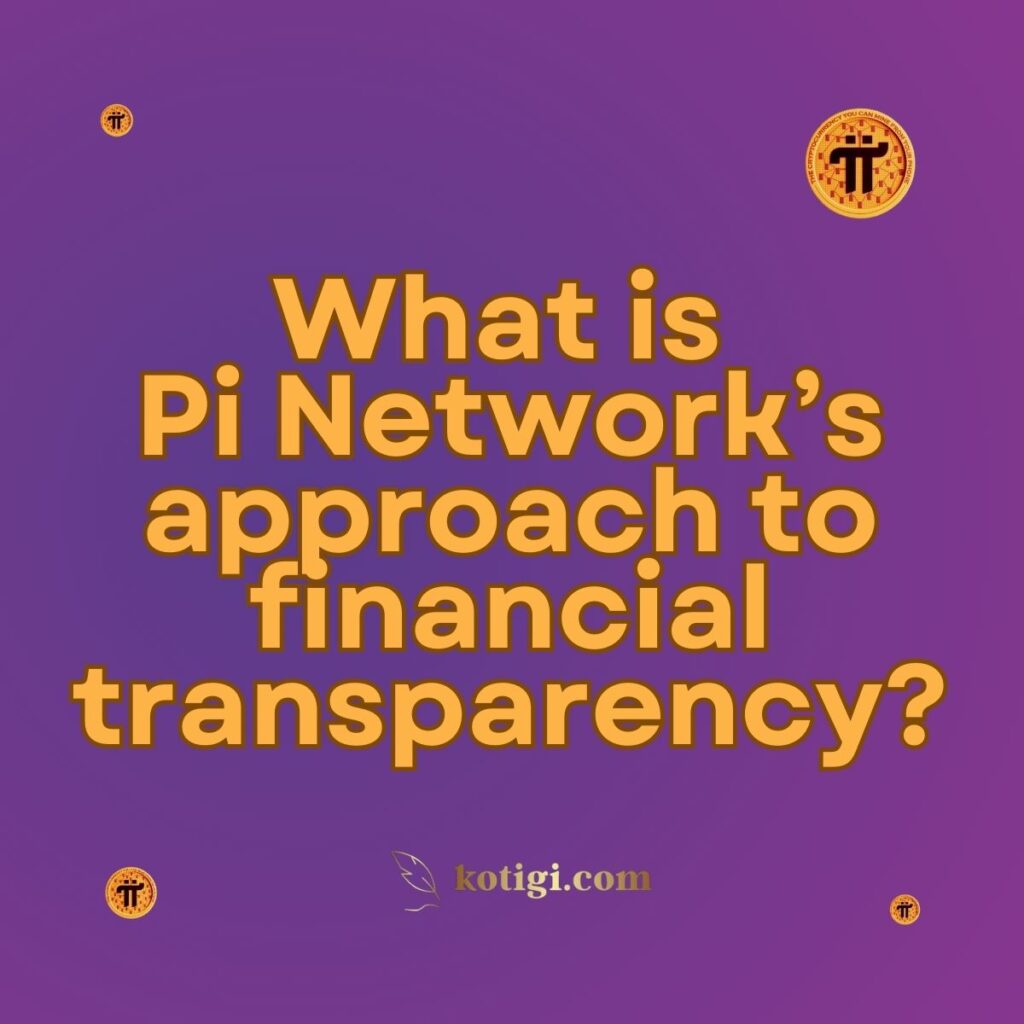
What is Pi Network’s approach to financial transparency?
Pi Network’s approach to financial transparency centers on ensuring that users have a clear understanding of the network’s operations, governance, and token economics. By fostering open communication, publishing whitepapers, and providing detailed insights into its financial processes, Pi Network seeks to build trust within its community and ensure its long-term sustainability.
Introduction
In the rapidly evolving world of cryptocurrencies, financial transparency is a crucial aspect that builds user trust and drives adoption. For Pi Network, ensuring a high level of transparency regarding its financial operations and tokenomics is fundamental to its mission. By providing clear information on how the network operates, how tokens are distributed, and how financial decisions are made, Pi Network fosters an environment of trust and accountability. This article explores Pi Network’s approach to financial transparency, its communication strategies, and its ongoing efforts to keep users informed about the network’s financial health.
1. Transparent Tokenomics
1.1 Clarity on Token Distribution
Pi Network’s approach to tokenomics is centered around providing users with clear information on how Pi tokens are distributed. The whitepaper offers detailed insights into the allocation of Pi tokens, including how much is reserved for miners, developers, and other key stakeholders. This transparency ensures that users understand the flow of tokens within the ecosystem and can trust the fairness of the network’s reward system.
1.2 Fair Mining Mechanism
Pi Network uses a unique mining model that ensures fair distribution of tokens to active users. The platform provides regular updates on mining rates, how they change over time, and what factors influence the reward structure. This level of openness helps users better understand how their participation contributes to the network’s overall health and ensures that rewards are allocated transparently.
1.3 Supply Control and Token Burn
Pi Network has mechanisms in place to control token supply and prevent inflation. The platform is transparent about its plans for managing the total supply of Pi tokens, including any potential token burns or reductions in circulation. This openness reassures users that Pi Network is taking a proactive approach to maintaining the value and utility of its native cryptocurrency.
2. Financial Governance and Decision-Making
2.1 Open Financial Governance Model
Pi Network takes an open approach to governance, ensuring that users have a say in major financial decisions. The platform encourages community participation in governance processes, allowing users to vote on key financial issues such as token allocation, development priorities, and future upgrades. This participatory model strengthens the community’s trust in how financial decisions are made.
2.2 Decentralized Decision-Making
One of Pi Network’s long-term goals is to transition towards a decentralized financial governance structure. By empowering its community through decentralized voting mechanisms, Pi Network ensures that no single entity has complete control over the platform’s financial operations. This decentralization is an essential aspect of Pi Network’s commitment to financial transparency and accountability.
2.3 Community-Driven Financial Proposals
Pi Network encourages users to submit financial proposals that could impact the future development of the platform. These proposals are discussed openly within the community, and users have the opportunity to vote on them. This inclusive approach to financial decision-making ensures that Pi Network’s financial direction aligns with the collective interests of its users.
3. Communication Strategies for Financial Transparency
3.1 Regular Financial Updates
Pi Network provides its community with regular updates on its financial health, including reports on token distribution, development funding, and operational expenses. These updates are published on official channels such as the Pi Network app, website, and social media platforms. This consistent communication ensures that users are always aware of the network’s financial status and any changes that may affect them.
3.2 Whitepapers and Roadmaps
To maintain transparency, Pi Network regularly publishes whitepapers and roadmaps detailing its financial strategy and future plans. These documents offer a comprehensive view of the platform’s tokenomics, governance, and planned developments. By sharing these insights, Pi Network gives users a clear understanding of how the network will grow and evolve financially over time.
3.3 User Engagement in Financial Discussions
Pi Network encourages users to engage in discussions about the platform’s financial strategies. Through community forums and social media groups, users can ask questions, share insights, and contribute to conversations about the network’s financial direction. This open dialogue fosters a sense of ownership among users and reinforces the network’s commitment to transparency.
4. Auditing and Third-Party Verification
4.1 External Audits of Financial Operations
Pi Network plans to introduce third-party audits to verify its financial operations and ensure compliance with industry standards. These audits will provide independent verification of the network’s financial processes, offering users an additional layer of assurance that Pi Network is managing its resources responsibly and transparently.
4.2 Ensuring Regulatory Compliance
As Pi Network continues to grow, it prioritizes adherence to international financial regulations. The platform ensures that its operations comply with anti-money laundering (AML) and know-your-customer (KYC) regulations. By maintaining transparency in these areas, Pi Network demonstrates its commitment to operating within the boundaries of legal and regulatory frameworks, further building trust with its users.
4.3 Transparency in Developer Compensation
Pi Network is open about how developers are compensated for their work on the platform. By providing clear information on how funds are allocated for development, the platform ensures that its financial decisions regarding developer compensation are fair and transparent. This transparency helps build trust within the developer community and encourages ongoing innovation on the platform.
5. Impact on User Trust and Adoption
5.1 Building Long-Term User Trust
Financial transparency is a key driver of user trust in Pi Network. By being open about its financial operations, Pi Network reassures its users that the platform is being managed responsibly. This trust is crucial for long-term adoption, as users are more likely to engage with and invest in a platform that is upfront about its financial practices.
5.2 Encouraging Participation through Transparency
Transparency in financial matters also encourages more active participation in the network. Users who understand how the platform operates financially are more likely to contribute to its growth, whether through mining, developing, or voting on governance proposals. Pi Network’s commitment to financial transparency thus plays a significant role in fostering a vibrant, engaged community.
5.3 Increasing Investor Confidence
For potential investors, financial transparency is a critical factor when evaluating a cryptocurrency project. Pi Network’s open approach to tokenomics, governance, and financial operations makes it more attractive to investors looking for projects with solid foundations and clear financial strategies. This transparency helps position Pi Network as a trustworthy platform in the competitive cryptocurrency market.
6. Future Plans for Enhancing Financial Transparency
6.1 Enhanced Reporting Tools for Users
To further enhance financial transparency, Pi Network plans to introduce new reporting tools that will allow users to track token distributions, governance decisions, and other financial data in real time. These tools will provide users with greater visibility into the platform’s financial operations and enable them to make more informed decisions about their participation.
6.2 Expanding Community Involvement in Financial Decisions
Pi Network intends to expand community involvement in financial decisions by implementing more decentralized governance features. This will give users even more influence over the platform’s financial direction, ensuring that decisions reflect the collective interests of the community.
6.3 Improved Transparency in Token Utility
As Pi Network continues to develop, the platform will place a greater emphasis on explaining the utility of its tokens in various aspects of the ecosystem. This will include providing detailed information on how tokens can be used within decentralized applications (dApps), staking mechanisms, and governance. By offering clear explanations of token utility, Pi Network aims to further strengthen user trust in its financial model.
Conclusion
Pi Network’s approach to financial transparency is a cornerstone of its efforts to build trust and foster a strong, engaged community. By providing clear information on its tokenomics, governance, and financial operations, the platform ensures that users have a comprehensive understanding of how it operates. Regular updates, user engagement, and third-party audits further enhance this transparency, positioning Pi Network as a leader in financial openness within the cryptocurrency space. As the platform continues to grow, its commitment to transparency will play a vital role in ensuring its long-term success.
Key Takeaways
- Transparent Tokenomics: Pi Network provides clear information on token distribution and mining mechanisms to ensure fairness.
- Open Financial Governance: The platform encourages community participation in financial decision-making, reinforcing trust.
- Regular Financial Updates: Users receive consistent updates on the platform’s financial status through official channels.
- Third-Party Audits: Future plans include third-party audits to verify the platform’s financial operations and ensure regulatory compliance.
- User Trust and Adoption: Pi Network’s financial transparency is key to building long-term user trust and encouraging active participation.





